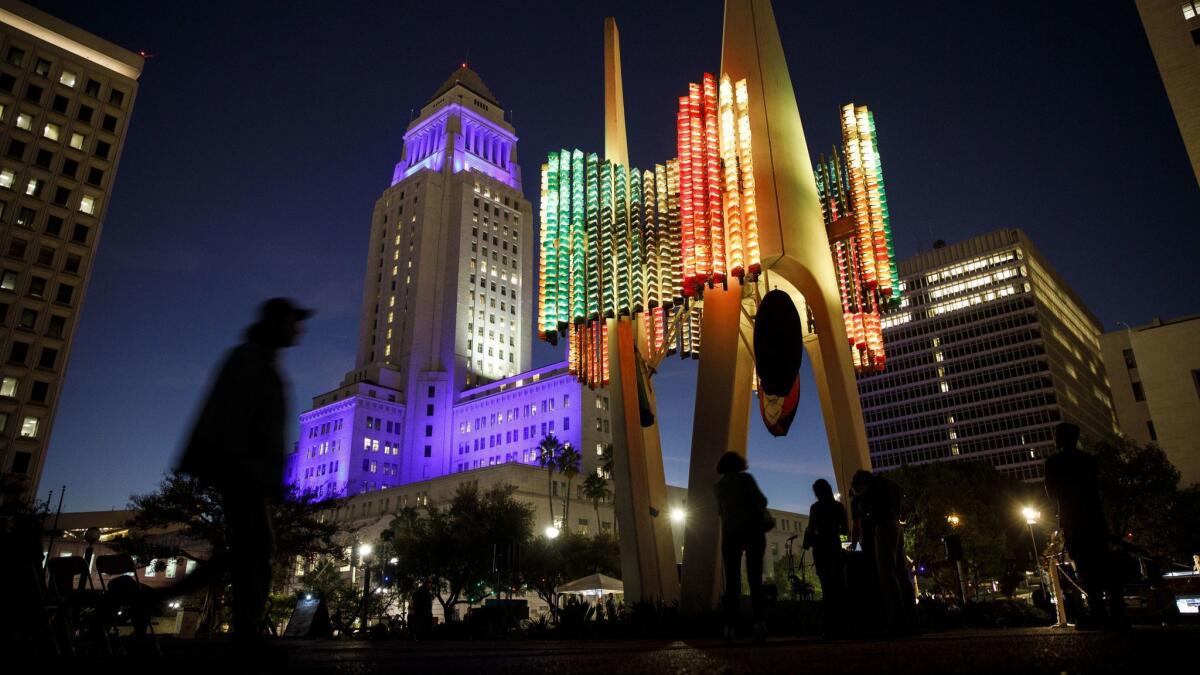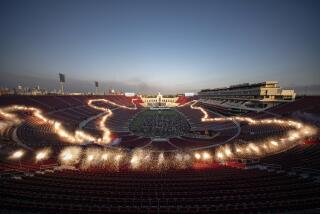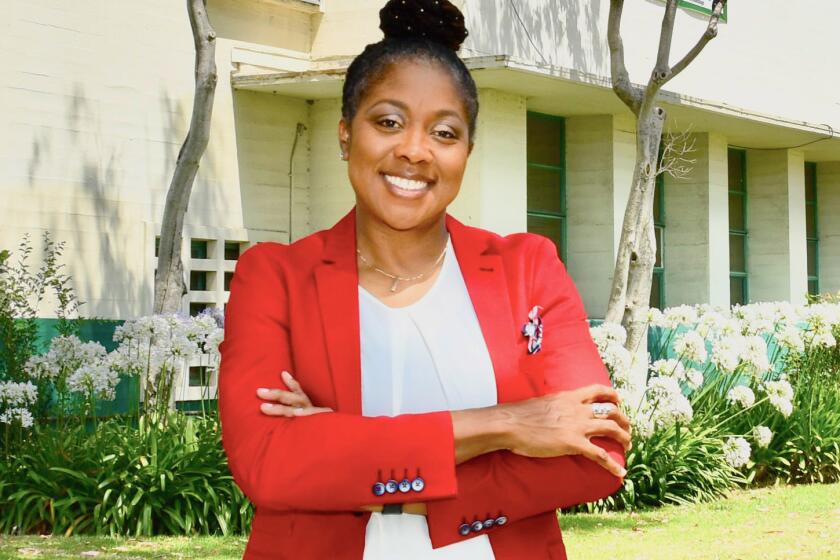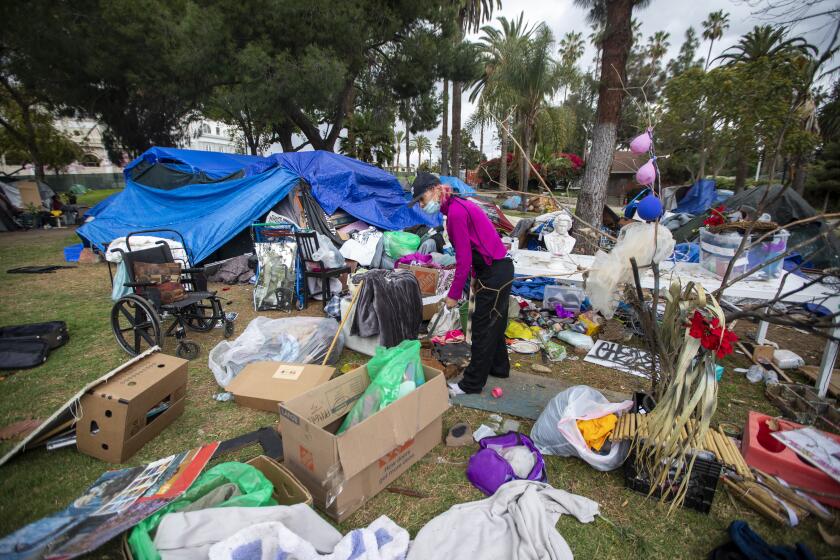After decades of silence, L.A.’s Triforium becomes the ‘pipe organ of light’ its creator meant it to be — for three nights

Built in 1975, the three-legged, 60-foot concrete tower and array of colored glass prisms has stood almost forgotten for nearly 45 years. (Patrick T. Fallon / For The Times)
For 43 years, the hulking monument of concrete and colored glass known as the Triforium has towered over Fletcher Bowron Square in downtown Los Angeles, an object of apathy once the mockery had quieted down.
Creator Joseph Young saw it as an instrument of cultural unity through music and light.
Critics ridiculed it as “Trifoolery,” “Psychedelic Nickelodeon” and “Schlockenspiel.” For most of the last four decades, it has sat dark and quiet, producing little but rust.
Then a trio of thirtysomethings fell in love with the Triforium, as both L.A. story and art. Their enthusiasm turned into a $100,000 grant, which has turned into a high-tech, digital rebirth, bringing synchronized music and light to an otherwise dreary corner of the Civic Center.
For the last two Fridays the Triforium dazzled thousands of onlookers with its “polyphonoptic” interface — as Young termed his forward-looking computer code that turned music into kinetic light.
In those performances it synced to the likes of multi-instrumentalist Reggie Watts, the Bob Baker Marionette Theater, electronic loop vocalist Julianna Barwick and tenors from the L.A. Opera singing arias from Philip Glass’ “Satyagraha.”
The link in this lineup of auditory incongruity is light. As the musicians played, their melodies, rhythms and tones were interpreted by 1,494 light-emitting diodes of ever-changing color encircling the three-legged, 60-foot concrete structure in vertical arrays.
Tonight’s performers will include alternative rockers Thao & The Get Down Stay Down, the Taikoproject drum ensemble and world champion whistler Molly Lewis.

Then it will be a bittersweet ending for the three millennials who won the Goldhirsh Foundation grant with the promise that a restored Triforium would “signal the flickering of a new movement, one that encourages people to reclaim and celebrate public artworks in their cities.”
It turned out that the six-figure grant was far from enough to keep the lights running.
After this week’s concert, the LEDs that were affixed to each prism by hand will come down, and the Triforium will again go silent and dark.
“We’re doing what we can with what we have,” said Claire Evans of the dance-pop band Yacht. Evans and partner Jona Bechtolt curated the eclectic events to showcase Young’s concept of the Triforium as a nexus for the cultural and artistic diversity of the city.
The pair and Tom Carroll, host of the web series “Tom Explores Los Angeles,” won the grant in 2016 and jumped in thinking that LEDs and microchips could breathe life into the Triforium that the technology of Young’s day could not.
Though the revival is only temporary, they say their lasting achievement was uncovering and bringing to life the depths of Young’s artistic vision that were never known before.
The insights came from the artist’s notebooks and punched-tape code, the standard of the day, which were provided to the project by his three daughters.
“He had to make a lot of technical compromises,” said Douglas Dunn, an expert on obsolete computers who probed Young’s code as a contractor for the project.
Young had imagined, for example, 127 intensities of brightness to correspond to intensity of sound, a requirement achievable with LEDs. The transistor-era computer, with only four kilobytes of memory, and incandescent lights could muster only three levels: full, middle and off, Dunn said.
In Young’s conceptual notes, Dunn found mystical and spiritual expression.
“Lots of shape- and geometry-related mysticism,” Dunn said. “He was really into mechanical calculators, like the circular slide rule.”
In one notebook, Dunn found references to the Triforium as evoking the main arch of a cathedral and “a pipe organ of light.”
“He wanted you to hear color and see music,” Carroll said.
The Triforium originally synchronized its lights to a 79-bell carillon that was removed long ago. Later, the lights were abandoned, and tape-recorded music occasionally played on its speakers.
To bring the original vision to life through multiple genres, Dunn connected a microphone and a laptop to the LEDs through an electronic controller.
Though the hand-blown Murano prisms are arranged in stacks of uniform color — another physical limit on Young’s imagination — the LEDs are so powerful their color shines through the glass, making possible the myriad color combinations a microprocessor can manage.
“This is the first time we’ve ever seen the Triforium in the way the artist originally intended,” said Carmen Zella of Now Art LA, who co-produced the events. “The daughters are super thrilled.”
The future of the Triforium now may depend on the funding needed to restore the aging structure.
Carroll said that would take about $1 million, a figure arising from the realities of rusted steel, sketchy wiring and bureaucratic process.
Among the hang-ups: The city wouldn’t allow the young entrepreneurs to simply connect new lights to the old wires — 1,494 of them laced from each prism through the concrete legs down to a control room in the underground mall.
And though there are electrical outlets in the square, the city didn’t approve their use. A rented generator was brought in to power the shows.
It also turned out that the steel bracing that held up the prisms was compromised by rust. And the concrete structure itself required a structural evaluation.
Reports required by the Department of Cultural Affairs added a year to the one-year project and established the seven-figure cost, Carroll said.
“We were naive,” Carroll readily admits, taking consolation in the thought that Young himself became disillusioned.
“Naivete has been a part of this project from the beginning,” Carroll said.
Young’s “polyphonoptic kinetic tower,” commissioned for the opening of the Los Angeles Mall in 1975, had problems from the beginning. Over the years it played only intermittently, its bulbs constantly burning out.
In a letter to The Times 18 months after the Triforium’s debut, Young added his own epithet to the many coined for the monument, saying the city’s “catatonic management” had made it a “million-dollar jukebox.”
Yet Young, whose works adorn buildings across Los Angeles, died in 2007 still believing that one day others would see the Triforium as he did: a vision of the “unfinished kaleidoscopic nature of the city.”
The fate of the Triforium now rests with a plan to restore the entire Los Angeles Mall, which connects Fletcher Bowron Square to the municipal building known as City Hall East via an underground passage.
City Councilman Jose Huizar, who represents downtown, has asked the city staff to prepare a plan to “make Civic Center a more engaging, pedestrian friendly, active and dynamic space.”
It’s not guaranteed that the Triforium, which has not been designated a historic-cultural monument, will be a part of that plan.
Carroll is hoping the three performances have improved the odds by building a fan base among the several thousand who attended.
“We just hope to stick the image in people’s heads,” Carroll said. “People will be more easily motivated.”
More to Read
Sign up for Essential California
The most important California stories and recommendations in your inbox every morning.
You may occasionally receive promotional content from the Los Angeles Times.











